
The Politics and Promise
of Yoga
Explorations in Indic Traditions: Theological, Ethical, and Philosophical
Series Editor: Jeffery D. Long, Elizabethtown College
Advisory Board
Purushottama Bilimoria, Christopher Key Chapple, Jonathan Gold, Pankaj Jain, Nathan Katz, Kusumita Pedersen, and Rita D. Sherma
The region historically known as the Indian subcontinent (and more recently as South Asia) is rich with ancient and sophisticated traditions of intellectual and contemplative investigation. This includes both indigenous traditions (Hindu, Buddhist, Jain, and Sikh) and traditions that have found a home in this region (Islamic, Christian, Jewish, and Zoroastrian). This series is devoted to studies rooted in critical and constructive methodologies (such as ethics, philosophy, and theology) that show how these traditions can illuminate universal human questions: questions about the meaning of life, the nature of knowledge, good and evil, and the broader metaphysical context of human existence. A particular focus of this series is the relevance of these traditions to urgent issues that face humanity todaysuch as the ecological crisis, gender relations, poverty and social inequality, and religiously motivated violenceon the assumption that these traditions, far from being of merely historical interest, have the potential to enrich contemporary conversations and advance human understanding.
Recent Titles in Series
The Politics and Promise of Yoga: Contemporary Relevance of an Ancient Practice, by Anjali Kanojia
The Hindu Self and its Muslim Neighbors: Borders of Belonging in Bengal, by Ankur Barua
The Philosophy of Sri Chinmoy: Love and Transformation, by Kusumita Pedersen
Gandhi and Rajchandra: The Making of the Mahatma, by Uma Majmudar
Swami Vivekananda: His Life, Legacy, and Liberative Ethics, edited by Rita D. Sherma
Beacons of Dharma, edited by Jeffery D. Long, Michael Reading, Christopher Miller
Thinking with the Yogasutra of Patanjali: Translation and Interpretation, edited by Christopher Key Chapple and Ana Funes Maderey
The Metaphysics of Paradox: Jainism, Absolute Relativity, and Religious Pluralism, by Wm. Andrew Schwartz
Digital Hinduism: Dharma and Discourse in the Age of New Media, edited by Murali Balaji
Sri Chaitanyas Life and Teachings: The Golden Avatara of Divine Love, by Steven Rosen
Shaktis New Voice: Guru Devotion in a Woman-Led Spiritual Movement, by Angela Rudert
The Vedantic Relationality of Rabindranath Tagore: Harmonizing the One and Its Many, by Ankur Barua
This work is dedicated to the gurus; their gratitude, grace, and blessings.
The Politics and Promise
of Yoga
Contemporary Relevance of an
Ancient Practice
Anjali Kanojia
LEXINGTON BOOKS
Lanham Boulder New York London
Published by Lexington Books
An imprint of The Rowman & Littlefield Publishing Group, Inc.
4501 Forbes Boulevard, Suite 200, Lanham, Maryland 20706
www.rowman.com
86-90 Paul Street, London EC2A 4NE
Copyright 2023 by The Rowman & Littlefield Publishing Group, Inc.
All rights reserved. No part of this book may be reproduced in any form or by any electronic or mechanical means, including information storage and retrieval systems, without written permission from the publisher, except by a reviewer who may quote passages in a review.
British Library Cataloguing in Publication Information Available
Library of Congress Cataloging-in-Publication Data
Names: Kanojia, Anjali H., 1978 author.
Title: The politics and promise of yoga : contemporary relevance of an ancient practice / Anjali Kanojia.
Description: Lanham : Lexington Books, [2023] | Series: Explorations in indic traditions: theological, ethical, and philosophical | Includes bibliographical references and index. |
Summary: Yoga is a popular and beneficial evidence-based health practice. This book addresses the origins, explores yogas evolution, and outlines current scientific research as well as contemporary discussions related to the possibilities as well as the politicization of this ancient Indian practice Provided by publisher.
Identifiers: LCCN 2022034698 (print) | LCCN 2022034699 (ebook) | ISBN 9781498599344 (cloth) | ISBN 9781498599351 (epub)
Subjects: LCSH: Yoga.
Classification: LCC B132.Y6 K333 2023 (print) | LCC B132.Y6 (ebook) | DDC 181/.45dc23/eng/20220909
LC record available at https://lccn.loc.gov/2022034698
LC ebook record available at https://lccn.loc.gov/2022034699
 The paper used in this publication meets the minimum requirements of American National Standard for Information SciencesPermanence of Paper for Printed Library Materials, ANSI/NISO Z39.48-1992.
The paper used in this publication meets the minimum requirements of American National Standard for Information SciencesPermanence of Paper for Printed Library Materials, ANSI/NISO Z39.48-1992.
Contents
I would like to acknowledge Dr. Long, the publisher, and everyones patience which allowed this book to happen. I am grateful to my family and friends and my yoga students and fellow practitioners for their enthusiasm and interest in the book.
Media Credits (Charts and Photos)
Purvi Baron
Avani Kanojia
Tina Nguyen
Six Darshanas
The Four Vedas
Ashtanga Yoga
Five Components of the Mind
Representation of Reality
The Four Yugas
The Prana Vayus
Human Life Cycle
The Four Asramas
The Four Purusharthas
Gunas, Tattwas, and Their Functions
Koshas or Sheaths
The Three Gunas
The Three Doshas
Types of Karma
Temple Layout
Architecture of Kandariya Mahadev Khajuraho Temple
Yoga Sutras Pada
Yama according to Maharishi Patanjali
Niyama according to Maharishi Patanjali
The Chakras
Muladhara Chakra
Swadhisthana Chakra
Manipura Chakra
Anahata Chakra
Vishuddhi Chakra
Ajna Chakra
Sahasrara Chakra
Complementary, Alternative, Integrative Medicine
Complementary Health Approaches
Namaste
The health of our body is of fundamental importance in life, claims the Swiss-born physician Paracelsus: Health isnt everything, but without health, everything is nothing (Jagtap, n.d.). Practicing yoga regularly improves physical, mental, social, and spiritual health (Yadav et al., 2015). Yoga is an ancient Indian health practice and part of a global economy. The yoga industry is estimated at $80 billion, and there are about 300 million yoga practitioners around the world, 72 percent of whom are female (Jeong, 2022). This spiritual practice has even generated fitness and yoga gurus with a large following. Yoga is practiced by over 36 million Americans, and according to data, the number of practitioners has doubled in the United States over the past decade (2002).
Medicine in general constitutes practices that reside outside mainstream structures, and these practices have existed for centuries (Jonas et al., 2013). Many philosophical systems and traditions have arisen in India, including theories of evolution that outline the development of human physiology and related complexities. Many of these philosophies are currently in practice, though yoga is one such philosophy (Kesarcodi-Watson, 1978).
Yoga is one of the six classical Indian philosophies or Satdarshanas, which are ways of seeing or knowing ourselves, our true self (Klostermaier, 2007). Yoga is, in essence, described by eminent yoga gurus as a self-discovery. This self-discovery is an implosive process that one strives toward. The yoga philosophy contains methods to develop clarity and awareness about ourselves by focusing and working on the mind-body-spirit complex. Yoga is thus the control of thought waves in the mind; yoga is the method to control the minds wavering (Prabhavananda & Isherwood, 1991).
Next page
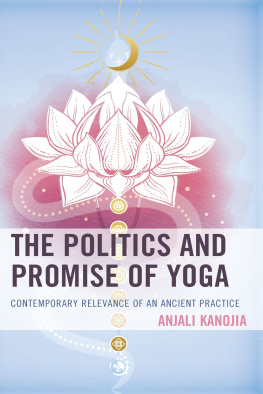
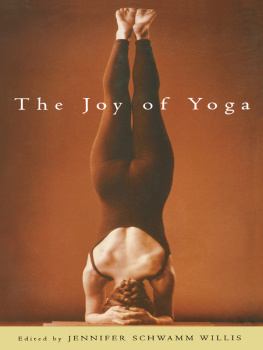

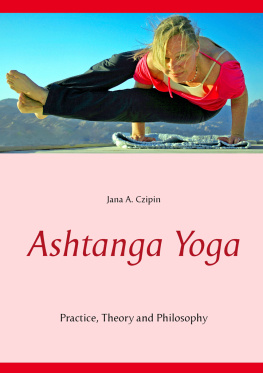


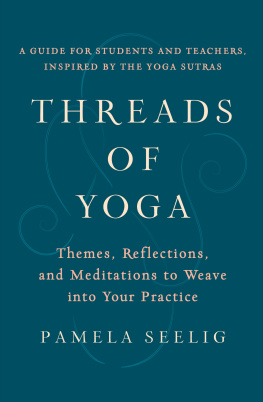

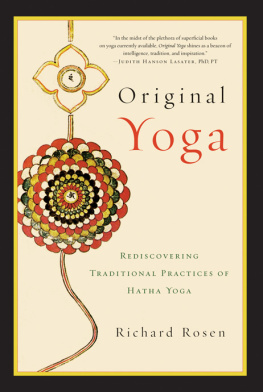


 The paper used in this publication meets the minimum requirements of American National Standard for Information SciencesPermanence of Paper for Printed Library Materials, ANSI/NISO Z39.48-1992.
The paper used in this publication meets the minimum requirements of American National Standard for Information SciencesPermanence of Paper for Printed Library Materials, ANSI/NISO Z39.48-1992.